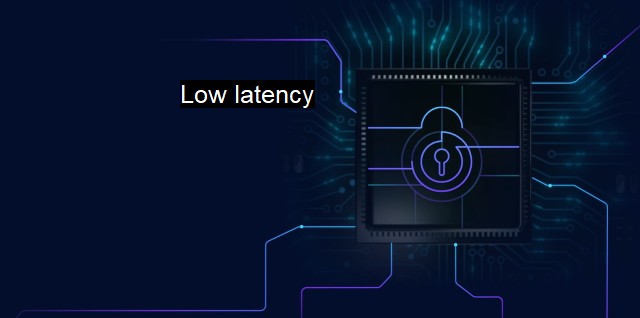What is Low latency?
The Importance of Low Latency in Cybersecurity and Antivirus: Ensuring Real-Time Protection Against Threats and Attacks
Low latency, a term common in technologies dedicated to cybersecurity and antivirus protection, characterizes the minimal amount of delay during the transmission of information over a network. latency represents the time taken for a packet of data to get from one point to another. So in the digital realm, prompt delivery of data and correspondences is crucial. A network infrastructure with low latency facilitates the proficient dispatch of information, aimed at making processes smoother, quicker, and more agile.Latency is rendered more significant when we delve into its practical implications anchoring on cybersecurity and antivirus measures. Bear in mind, latency can undercut an organization’s efforts to safeguard their digital assets. High latency may indicate network bottlenecks or potential malicious activity impeding smooth transmission of legitimate traffic. Usually, these latencies stem from attacks known as Distributed Denial of Service (DDoS) that aim to exhaust network resources by flooding the network with unmanageably high levels of useless traffic.
Low latency network architectures dramatically reduce these transmission delays, bolstering cyber-defenses, providing rapid responses to potential threats, and instinctively triggering actions for their instantaneous elimination. This way, with low latency, primer defenses get hardened, the virus scans occur faster ensuring quicker detection, handling, and eradication of harmful intruders.
Contemporary antivirus solutions and cybersecurity platforms are progressively leveraging low latency to their advantage. Decreased latency quickening the communication between servers, end-user terminals, and protection technologies inherently speed up detection, enabling early isolation of harmful programs. antivirus scanners require instantaneous communication and coordination between different components for real-time scanning, ascertaining potential threats, and thwarting them before damage occurs. Low latency ensures these processes happen almost instantaneously, optimizing responsiveness to threats in real-time.
Other applications where the concept of low latency ferments in cybersecurity include Intrusion Detection Systems (IDS), Intrusion Prevention Systems (IPS), and next-generation firewalls. These technologies dictate low latency to expeditiously identify, analyze, and respond to incoming threats. High-latency networks can significantly hamper the effective functioning of these protective systems, leaving organizations vulnerable.
Achieving low latency, especially amidst an era of unprecedented cyber threats, is both challenging and necessary. Measures such as incorporating specialized hardware appliances, deploying Bandwidth Delay Products (BDPs), optimizing network bandwidth, refining routing strategies, and integrating next-generation cybersecurity tools in the network, can all significantly reduce latency.
The drive towards zero-trust networks and Software-Defined Perimeters (SDP) also construe the significance of low latency in cybersecurity. Encapsulated in a "need to know" principle, zero-trust networks advocate low latency for quick processing and verification of every digital request at every checkpoint, negating every scope of unauthorized access, and reducing the risk of network vulnerabilities and data breaches.
Likewise, 5G and future generation networks with their promise of ultra-low-latency capabilities offer unprecedented opportunities for advanced cybersecurity measures. Low latency here translates not only into faster threat detection but equally speedy incident response times as well, hardening the enterprise networks against potential attacks.
Low latency in cybersecurity coincides with more than a simple ability to transfer data quickly. Being an integral part of comprehensive cyber defense strategies, low latency enables swift real-time responses to emerging cybersecurity threats, allowing organizations to promptly detect, isolate, and eliminate aggressive intrusions. With the ascent of sophisticated cyber-attacks, the importance of maintaining and continually improving low latency outputs will only keep growing. Hence, companies must anchor strategic focus on incorporating more innovative, low-latency solutions into their cybersecurity frameworks to ensure optimal protection across the digital spectrum.

Low latency FAQs
What is low latency in the context of cybersecurity and antivirus?
Low latency in the context of cybersecurity and antivirus refers to the speed at which security solutions detect and respond to threats. A low latency solution can quickly identify and mitigate threats, reducing the risk of damage to systems and data.Why is low latency important in cybersecurity and antivirus?
Low latency is important in cybersecurity and antivirus because it enables faster threat detection and response. The faster a threat can be detected and mitigated, the less damage it can cause. This is especially important in the constantly-evolving landscape of cybersecurity threats.How can low latency be achieved in cybersecurity and antivirus solutions?
Low latency in cybersecurity and antivirus solutions can be achieved through various means, such as using faster processors, minimizing network latency, and optimizing algorithms. Additionally, leveraging artificial intelligence and machine learning can help improve the speed and accuracy of threat detection and response.What are the benefits of low latency in cybersecurity and antivirus?
The benefits of low latency in cybersecurity and antivirus include faster threat detection and response, reduced risk of damage to systems and data, and improved security posture overall. Additionally, low latency can help organizations meet compliance requirements and avoid costly security incidents.| | A | | | B | | | C | | | D | | | E | | | F | | | G | | | H | | | I | | | J | | | K | | | L | | | M | |
| | N | | | O | | | P | | | Q | | | R | | | S | | | T | | | U | | | V | | | W | | | X | | | Y | | | Z | |
| | 1 | | | 2 | | | 3 | | | 4 | | | 7 | | | 8 | | |||||||